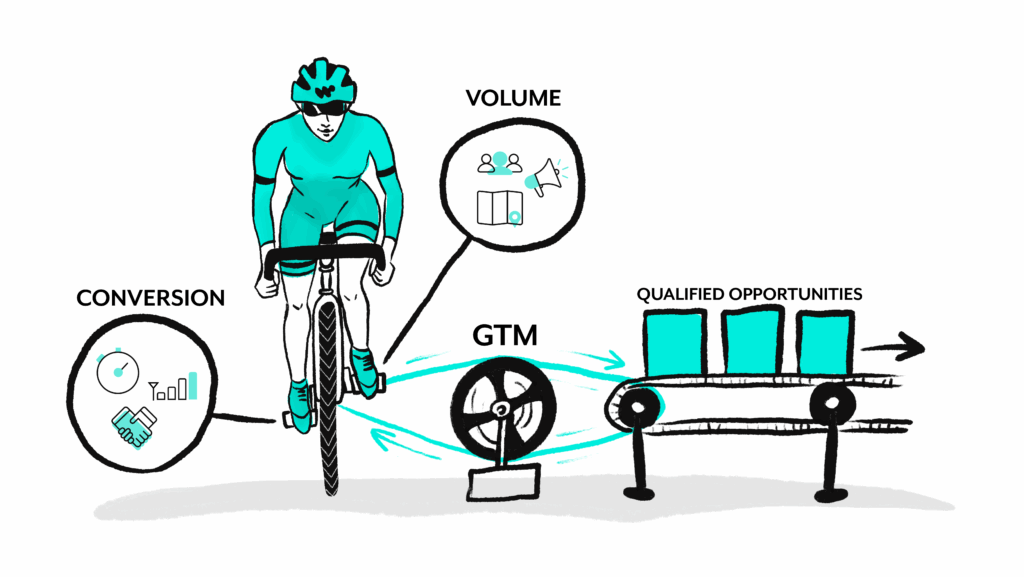Most companies consider RevOps a cost center: the folks who maintain systems, build dashboards, fix technical issues, and manage all the “plumbing” behind the go-to-market engine.
Important? Yes. Strategic? Not in the way sales or marketing typically get to be.
But we’re starting to see innovative companies pursue a new RevOps model—one where sales, marketing, and customer success ops teams don’t just support revenue, they create it. At these companies, RevOps is shifting from reactive to proactive, orchestrating revenue generation by automating processes like cold outbounding, deal reactivations, and customer engagement around renewals.
And it starts by asking a simple but radical question: “What if your back office is actually your revenue engine?”
RevOps as a revenue engine
RevOps is already in the best position to drive results. No other team sits at the intersection of so many revenue systems, workflows, and insights. They own the data, the tools, and the processes. And they touch every part of the customer journey from marketing to sales to customer success.
If the mandate is to grow pipeline, RevOps can push both pedals:
- Increase volume (more leads, better coverage).
- Increase conversion (better handoffs, faster cycles, stronger signals).

RevOps is perhaps the only team that’s set up to influence both volume and conversion at the same time. Not only does RevOps understand the marketing and sales data, they know the systems and automations. They see the information that flows through their systems, and know where the gaps lie.
So why hasn’t every company tapped into that potential?
Because most still put RevOps in the back office. It’s time to change that.
How RevOps can grow pipeline
One of the best examples of RevOps flexing its growth engine muscles comes from Jeff Long at Snowflake.
A while back, Snowflake’s sales leaders came to Jeff with a difficult question: “We want to convert more pipeline, but we can’t hire more SDRs. How can we scale outbound without adding headcount?”
Jeff had an answer. He built AI-powered automated cold outbound in Workato that:
- Pulls account data from Salesforce, Snowhouse, and ZoomInfo
- Searches the web for the latest company news about the account
- Searches an internal database for relevant case studies
- Composes an email using this data and generative AI
- Reviews and scores the quality of the initial output message
- Rewrites the message if it scores low
- Places the email in Outreach
The result? Snowflake’s outbound capacity ballooned. Every week, SDRs get 300–500 outbound-ready accounts, already enriched and staged for Outreach—with only a few minutes of manual work.
And conversion? Also up. In the first 6 months of the pilot, SDRs were 200%+ more likely to book a meeting using Jeff’s automation.
That’s not just operational efficiency. That’s pipeline directly created by RevOps.
Jeff goes into more detail about the project in this interview, if you’re interested.
From admin to GTM engineer
If you want RevOps to generate revenue, you need the right team structure.
RevOps teams are often divided by function: sales, marketing, customer success. But these swimlanes create handoffs, misaligned goals, and a narrow view of revenue operations.
At Workato, we’ve moved to a more integrated structure. Ops teams support the GTM teams they’re embedded in, but they work from a shared strategy, shared data, and shared automation platform.
That means one person might manage full-funnel automations from MQL to closed-won. Another might own email, campaign operations, or reporting across the entire funnel. Everyone’s accountable to outcomes, not just systems uptime.
And with the rise of the GTM Engineer and Growth Hacker roles, we’re seeing even more crossover between ops and growth. These are technically fluent operators who use automation, AI, and data orchestration to accelerate GTM results. They’re now some of the most valuable RevOps roles.
If you want to make the GTM Engineer role work, structure matters more than the title.
At some companies, GTM Engineers operate in isolation: building their own tools, running side projects, or acting as lone problem-solvers for a specific team. But this approach creates more tech debt than traction.
The most effective GTM Engineers work closely with your RevOps strategy. They build on shared data models, use the same automation platform, and work toward shared goals like pipeline acceleration or lead conversion. That structure gives them freedom to build, but focus to work on the right things.
If you’re curious, you can read more about Workato’s team structure.
“Rev” your RevOps engine
The biggest factor stalling the RevOps revenue engine? Time.
The backlog is always looming. There’s no breathing room to experiment, test new ideas, or build workflows that aren’t explicitly urgent. But that’s exactly the kind of work that actually affects revenue.
Jeff Long and his counterparts typically stay after hours to automate their processes, as there’s simply not enough time in the work day to both support GTM teams and build a RevOps revenue engine.
At Workato, we take inspiration from Google founders Larry Page and Sergey Brin, who championed the idea of “20% time” to focus on innovation and strategic initiatives. For us, that could mean building AI-powered workflows, improving funnel conversion, or proactively identifying gaps in GTM execution.
This doesn’t just accelerate pipeline. It also makes RevOps a more attractive place to work. Team members get to build, learn, and grow—not just clear Jira tickets.
RevOps will never be the same
If you’re in RevOps, this is your moment.
AI is redefining workflows. Automation is enterprise-ready. And the lines between ops and growth are blurring fast.
You’re no longer relegated to the back office. You’re a revenue owner now.
And the next big boost to your company’s pipeline? It just might come from you.

